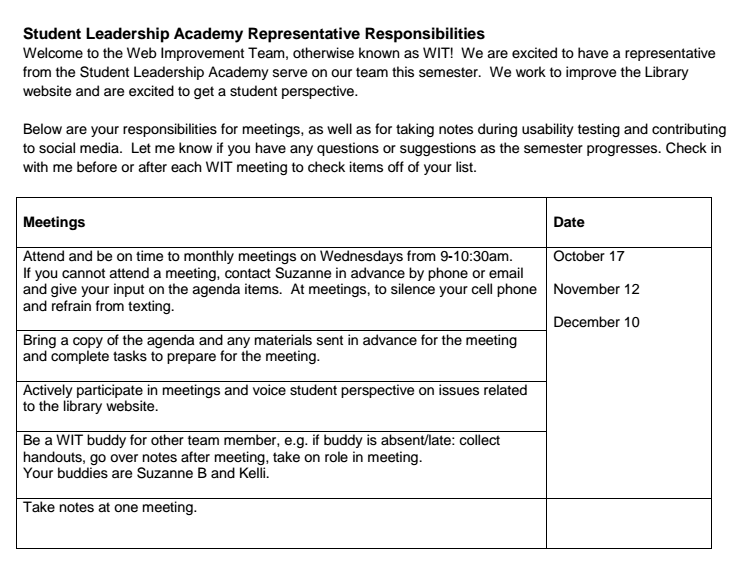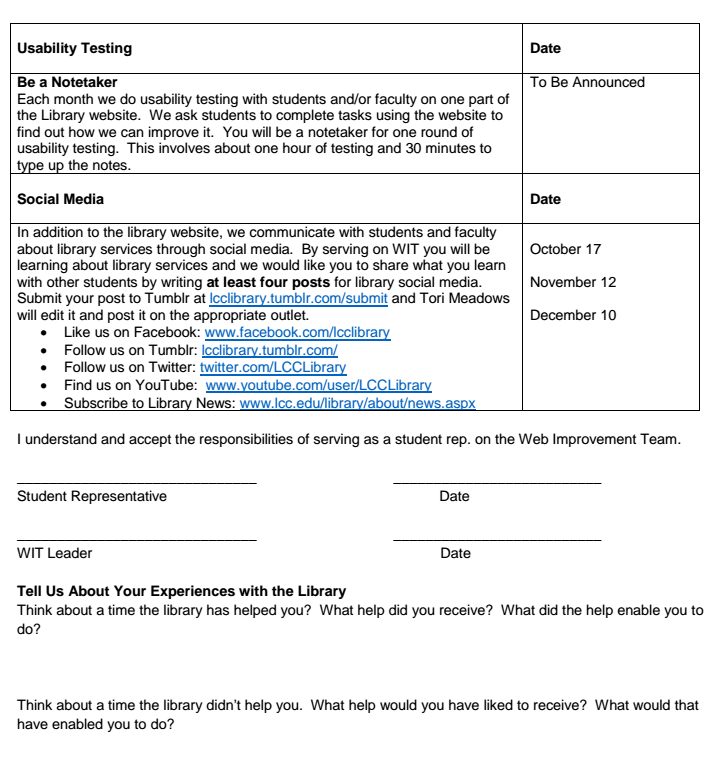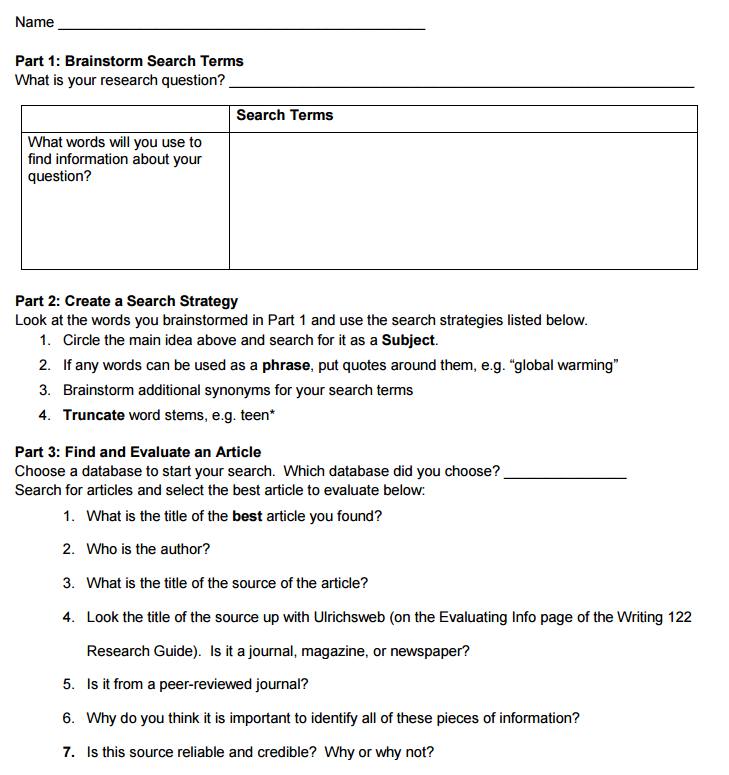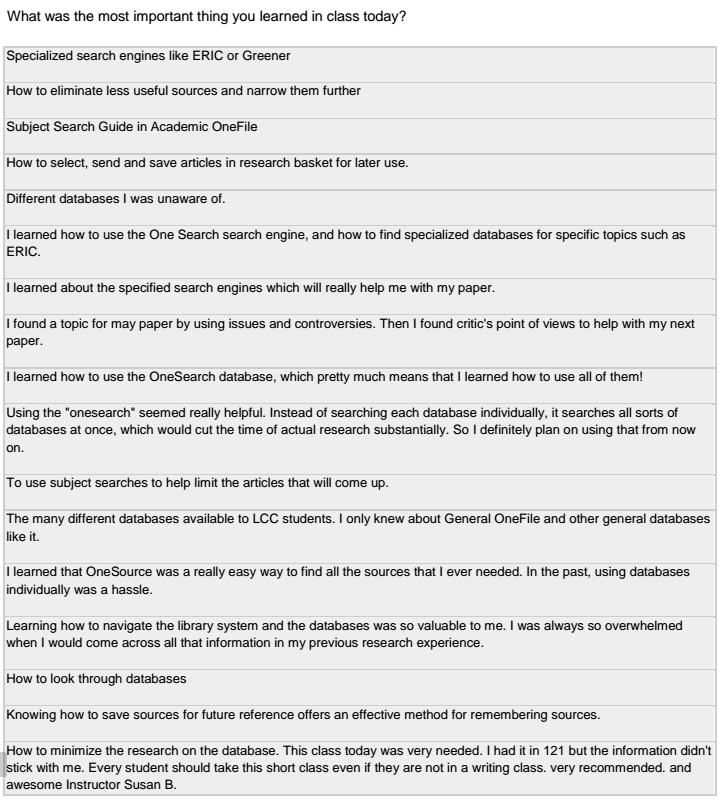Help Students Help Themselves
Part of my job as web services librarian is to make the website easier to use so that students can focus more of their energies on the critical thinking and evaluating stage of information seeking. With over 100 databases available to choose from, it can be overwhelming for students to know where to start. Librarians create Research Guides to pull together resources from a variety of formats to make it easier for students to know where to begin their research. However, it is challenging to create guides that are easy for students to use. When we first set up the Research Guides, there was no process for evaluating and creating new guides and we created many guides with little input from faculty and students. Since then, I have set up a process for proposing new guides and conducting usability testing of new guides. This process requires librarians to consult with faculty before a new guide is created so that the guide can be tailored to specific assignments. Doing usability testing with students to see if the guide actually helps students complete tasks related to the assignment has been an effective way of teaching librarians to follow the mantra of “less is more.” Usually usability testing leads to reducing content on the draft research guide so that the essential content stands out.
Make the Website Accessible for All Students
One major goals of our website redesign in 2011 was to clean up the language used on the website to make it more accessible to novice and experienced library website users. I developed a style guide for the website to create consistency across pages to make pages easier to scan. One difference between low-literacy and high-literacy website users is that low-literacy users tend to read every word on the page, whereas advanced users tend to scan. Writing for the web involves creating headings to make pages easier to scan, as well as cleaning up the writing to help those less experienced website users who do read every word. I worked with Victoria Meadows to develop a guide that is used to train staff in Writing for the Web. Then, in 2014 we completed a content review process and reviewed all of the pages on the website and removed pages that were not adding value to the website to better highlight pages that are.
Since 2011, we have had student representatives from the Leadership Academy serve on WIT to provide a student perspective. Many of these students are not familiar with the Library website at all when they join WIT. I developed a contract for students who serve on the team to make expectations clear.
Hearing directly from students at our meetings and having to explain topics that can be complex in a way that non-experts can understand has improved our discussions at WIT. Also, students have been valuable partners in finding other students for usability testing. Serving on WIT benefits students as they get experience in a professional environment and they learn more about library resources and services that can benefit them in their studies.
Build on What Students Already Know
In library instruction, I provide students with input that is a little bit beyond what they already know and to link what they know with the unfamiliar. When I am teaching students about the tools available in databases, I explain that they can save articles to print or email at the end of their search, similar to using the shopping cart in Amazon or another online shopping site. When I teach students to brainstorming synonyms before they search, I ask students them what words they might need to use to find a lawyer or a car repair person (attorney or automobile mechanic). Finally, I use an image of a pop can to see how many different words students can think of that describe the can. They are usually surprised that they can think of so many words from soda, to pop, to carbonated beverage. When they realize that there are so many different ways to describe a simple object, such as a pop can, they start to understand that they are even more ways to describe the more abstract concepts that they are researching.
Encourage Participation and Active Learning
One of the most challenging aspects of teaching one shot information literacy sessions is to build rapport and actively engage students in the session. I set expectations for participation at the beginning of the session by giving students a quick polling question. I try to lower the students’ affective filters by allowing them to participate anonymously electronically. I have experimented with using Padlet (an online whiteboard) for students to brainstorm search terms electronically. This method allows students who might be reluctant to speak in front of the whole class the opportunity to participate. I also encourage participation by asking for volunteers throughout the session and have started to carry bright pink reporter cards to each session. Each row gets a card and they have to choose a Reporter to share what they discussed before I call on their row. This helps set the expectation that participation is not optional, but also allows students to be prepared to speak.
I believe that active learning is the key to student learning and engagement. For example, my lesson for Writing 122 begins with an active learning activity where students work in pairs to examine a magazine article and a journal article to learn about the differences between these types of sources. 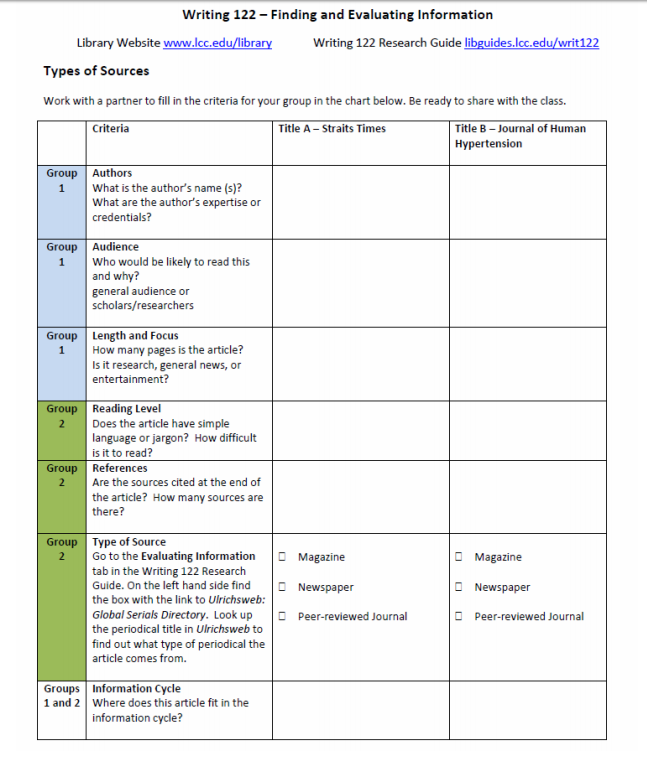
After this activity, we work through a sample search as a class and then students have time to find articles about their own topic by completing a guided worksheet.
Students are required to turn in their worksheet so that I can assess their learning and provide feedback to the instructor. Having to turn in the worksheet makes the students feel accountable for their learning and they take the session more seriously.
Assess the Effectiveness of My Teaching and the Website
I use a variety of methods to assess my teaching skills. I use polling throughout the session to get formative feedback on student learning. Often, I begin the session by asking students to decide if the following statement is true or false: All information is available for free through Google. This activity allows us to discuss what a research database is and many students are shocked by the idea that everything is not available online for free. At the end of the session, I give students in some courses, such as Writing 121, a quiz in Desire2Learn. This is invaluable because it allows me to see which areas I am teaching well and where I have room for improvement. Sometimes a very quiet class performs better than expected or a very talkative class does not perform as well. At the end of class, I have students complete a One Minute Paper to share the most important thing they learned along with unanswered questions. Combining the use of the one minute paper and the quiz gives me qualitative and quantitative data to evaluate my teaching. I share these results with the classroom instructor so that they can follow-up on any misconceptions and reinforce what students learned in the Library.
To assess the website the effectiveness of the website, one tool we use is website analytics gathered from Google Analytics, results from the Google Custom Search Engine set up to search the Library website, and Crazy Egg. Google Analytics shows the most popular pages on the website which helps us focus on improving the most popular pages. However, there are limitations to analytics. While the data can tell us that a search box is being used a lot, it cannot explain why someone is using it. For example, when we had a search box on the Library Research Page we found it was used a lot. However, students were using it to search for articles, not to find databases, so we removed the box.
Usability testing allows you to answer these questions that analytics cannot answer. Watching students try to use the website to do research is eye opening and a much better use of staff time than arguing over what language we should use to label a link in a meeting. Usability testing also allows us to meet students who may or may not be familiar with the Library website and make connections. Now that we are doing usability testing of research guides, we are testing targeted groups, such as fashion design students, and students are often excited to be the first to see a new research guide and eager to use the resources they learn about through testing.
How Methods Have Changed & Expected Areas of Growth
One area that has changed since my last review is a focus on user experience and the realization that “you are not your user.” This plays into my work in reference, instruction, and the website. Completing the courses to earn my Certificate in User Experience, I was constantly reminded that the way I think is not the way the students or staff I work with think. This makes processes such as testing the website with students, reviewing my lesson plan with the student perspective in mind, and thinking about research as a novice researcher essential.
I have also tried to find ways to get more staff involved in the website whereas before I focused mostly on the members of the Web Improvement Team. Staff members now post new content on the discussion board in the Library Community in myLCC and anyone can give feedback on new content. The content review process we recently completed was done with the help of all library staff. Also, I have documented the usability testing process so that it can be used by other staff members. These processes make the ongoing maintenance of the Library website go more smoothly (see Appendix H). I am planning to continue this process of training more staff in working with the website as I am delegating some of my responsibilities related to managing library videos, the online tutorial, and website content to other staff members.
I have also made changes in my instruction techniques since my last performance review. I have tried to apply the philosophy of “less is more” that I learned through my work with the website to my library instruction sessions. For example, I recently removed the detail about search strategies from my Writing 122 handout and instead gave students space to take their own notes based on the class activities. I have found that students are less overwhelmed and taking notes forces students to put ideas down on paper in their own words. I have also integrated the use of new tools to assess my teaching, such as using polling throughout the instruction session.
I have been approved to take a sabbatical spring of 2016 and the purpose of my sabbatical is to research the following questions:
- What types of assignments do faculty give which require research?
- How successful are students in completing these assignments?
- What type of support do students need to complete research assignments?
To answer these questions, I will be surveying faculty and students, as well as planning for campus-wide assessment of information literacy. I hope to get additional training in assessment before my sabbatical and expect my skills will develop in this area. I hope to apply what I learn about assessment not only to instruction but to all areas of the Library.
